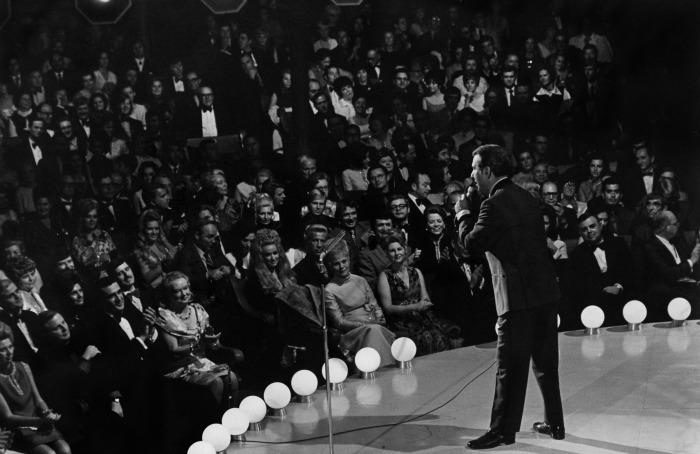
Posted on 09/23/2023 4:09:04 PM PDT by simpson96

Tennessee Ernie Ford sings the classic folk song, "Shenandoah" on The Ford Show, March, 9, 1961.
Many artists have covered the song, but Tennessee Ernie Ford released the most notable and popular version on his 1959 album, "Shenandoah". This live version from The Ford Show is heartfelt and inspiring.
This live recording appeared prominently in the popular video game "Fallout 76." The game also included the Ford's renditions of the miner's anthem "Dark as a Dungeon" and "Sixteen Tons." All three songs play on the game's Appalachia Radio.
"Shenandoah" - Tennessee Ernie Ford (March 9, 1961)
(Excerpt) Read more at youtube.com ...
That voice is incredible
The song seems to be about a pioneer or traveler from Virginia’s Shenandoah Valley in the mid-nineteenth century who is headed west and who has grown nostalgic about his home, maybe having second thoughts about leaving. He would be wise to put these thoughts aside and keep going, because he wouldn’t want to be hanging around the Shenandoah Valley in the 1860’s.
I've got several of their albums.
I love the song, but never understood why the author is singing about the Shenandoah River then says he is bound across the wide Missouri. I looked the song up and found the "Ballad of America" site has a great explanation of the roots of the song. Like any ballad, the roots are obscure and lost in time.
OVERVIEW
There are few melodies as recognizable as that of the American folk song "Shenandoah." As with most folk songs, there are many different variations and versions, and it is impossible to determine the song's exact origin. It has commonly been sung as a sea shanty (also spelled chantey or chanty), though it most likely originated with early French Canadian fur traders.Versions of the song have linked it to riverboat men, cavalry men, mountain men, and soldiers on both sides of the Civil War. Some use names, including Sally Brown, Polly Brown, Darby Doyle, Paddy Doyle, or Dan O'Shea, in place of the word Shenandoah.
In summing up the beauty and appeal of the song, John and Alan Lomax write in their book Best Loved American Folk Songs:
The melody has the roll and surge and freedom of a tall ship sweeping along before a trade wind. The sonorous succession of long vowels and soft and liquid consonants blend perfectly with the romantic air. The lines are a call from the homeland to the sailor wandering far out across the seas, a call not from a sweetheart, a house, or even a town, but from the land itself, its rivers and its familiar and loved hills."Shenandoah" was one of the most popular capstan shanties. Songs such as this set an appropriate, manageable pace and inspired the sailors to accomplish the task at hand, which could be quite long in duration.SONG HISTORY
The song first appeared in writing as "Shenadore" in The New Dominion Monthly in April, 1876. The author, Captain Robert Chamblet Adams, indicated that he had first heard the song around 1850. W.B. Whall reprinted it in his 1910 book Ships, Sea Songs and Shanties Collected by W.B. Whall, Master Mariner. The lyrics tell the story of a canoeing voyageur, or fur trader, who was in love with the daughter of a Native American chief.This earliest known version of the song likely originated with French Canadian voyageurs who traded with Native Americans around the Great Lakes starting in the 16th century. The voyageurs gave weapons, tools, and money in exchange for animal furs, especially beaver pelts. They often sang while they paddled their canoes along the Mississippi River and its tributaries, including the Missouri, in the quest for furs.
Most musicologists agree that the chief mentioned in "Shenandoah" is the Oneida Iroquois chief John Skenandoa. Skenandoa supported the English against the French in the Seven Years (or French and Indian) War. Support for the English may be the reason that the chief forbade the love between his daughter and the French trader, if the story in this early version of "Shenandoah" is true.
Flatboatmen carrying goods on the American rivers in the early 19th century may also have sung versions of "Shenandoah." Sailors on packet ships along the Mississippi River sang it while they hauled in the anchor. Eventually, sailors on American clipper ships carried the song around the world.
The Trapper and His Family
"Fur Traders Descending the Missouri" - painting by George Caleb Bingham
I remember from a visit to Stephen Foster Memorial that Foster used the Suwanee because no other southern river would fit, even though the lyrics of the song are not suggestive of the Suwanee environs. The Pee Dee would have been a better choice, but “Way down upon the Pee Dee River” wouldn’t have made it. I’ll bet “Missouri” is in this song for the same reason, because it certainly is more appropriate for the Mississippi.
Disclaimer: Opinions posted on Free Republic are those of the individual posters and do not necessarily represent the opinion of Free Republic or its management. All materials posted herein are protected by copyright law and the exemption for fair use of copyrighted works.